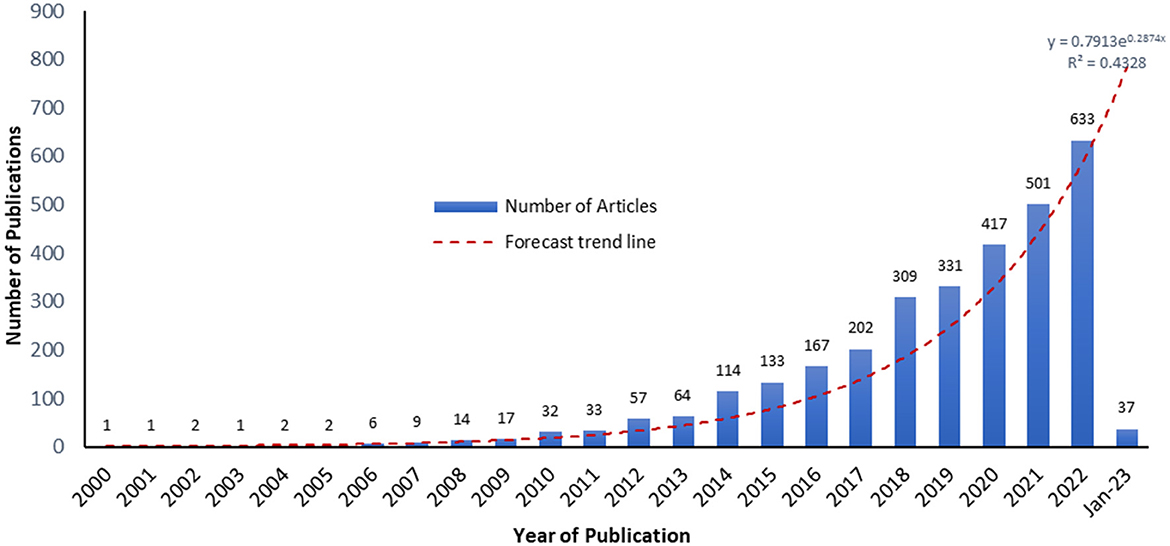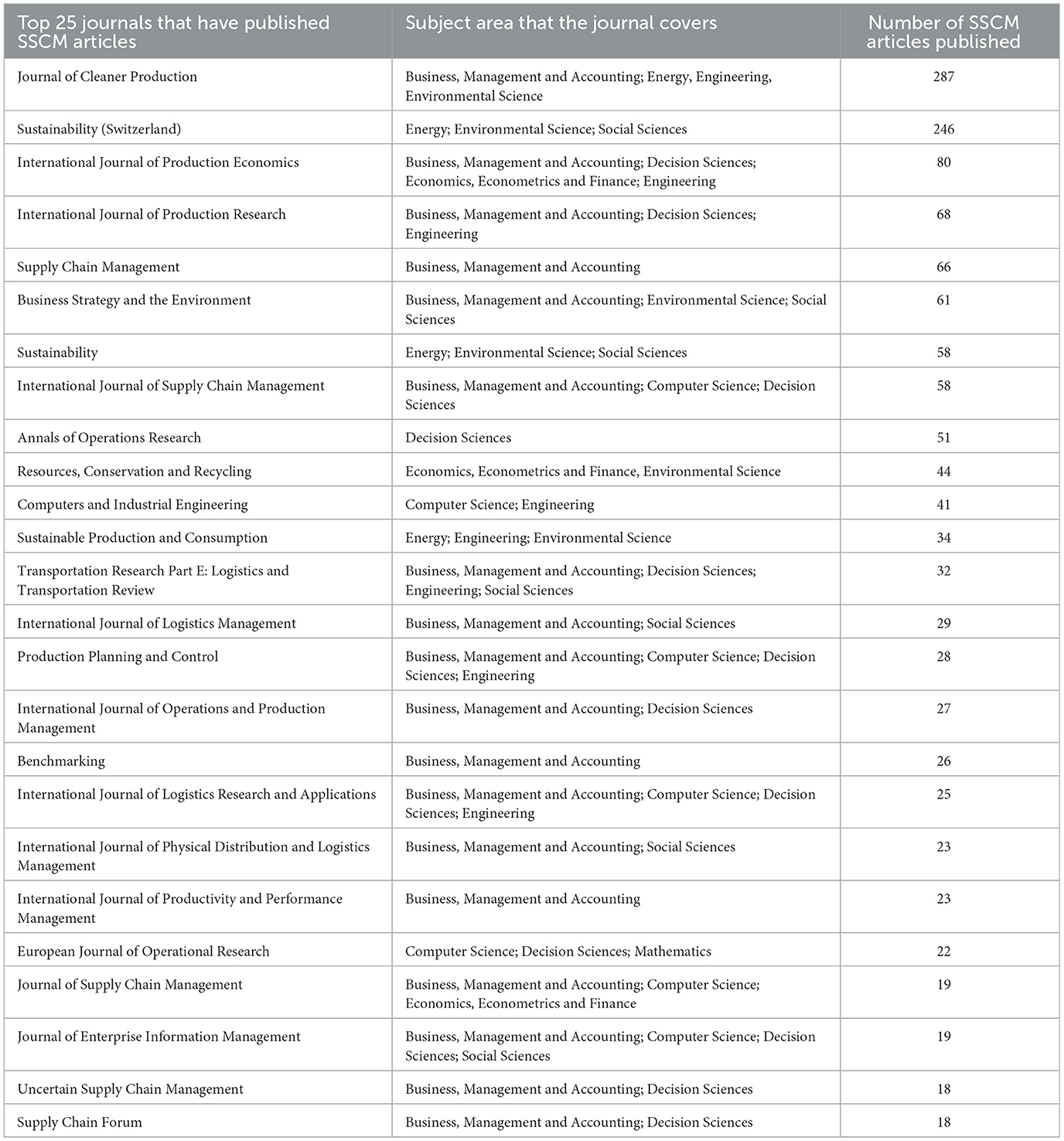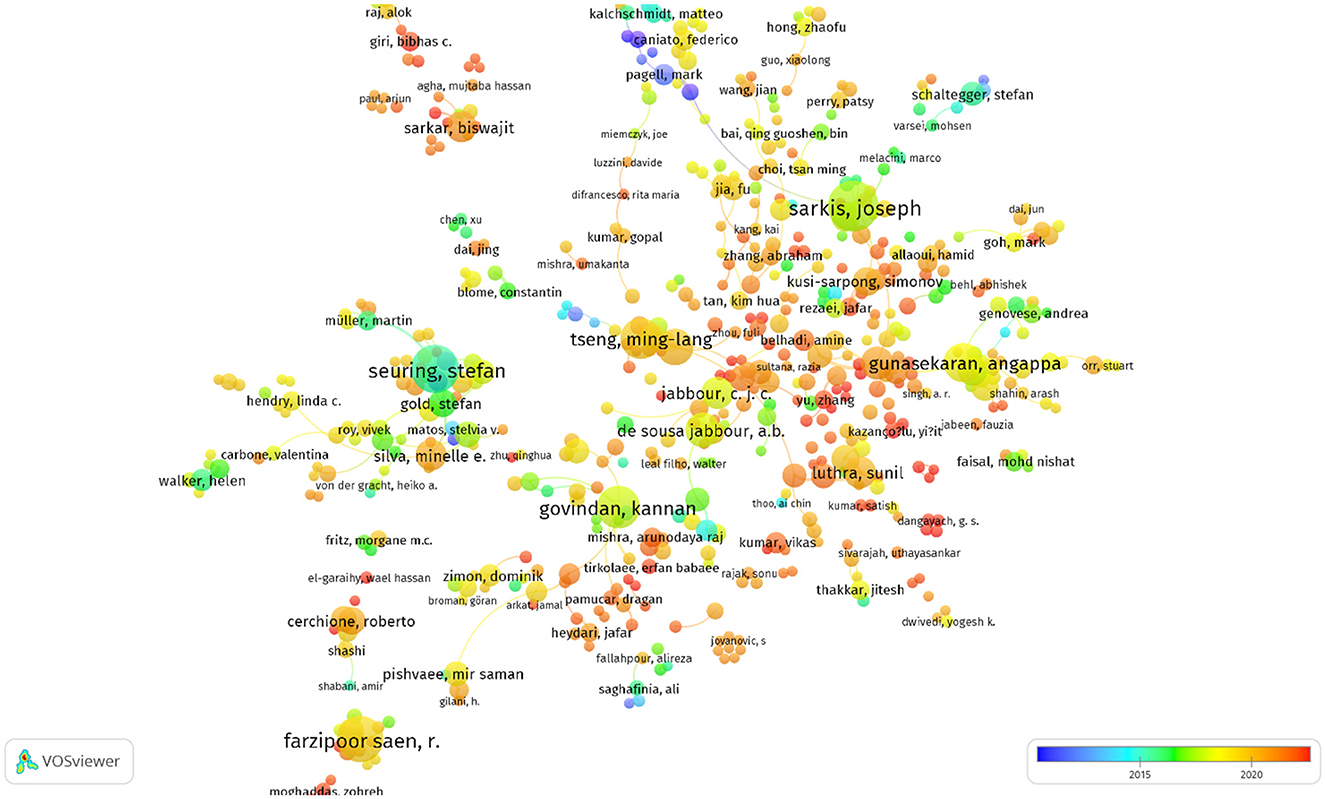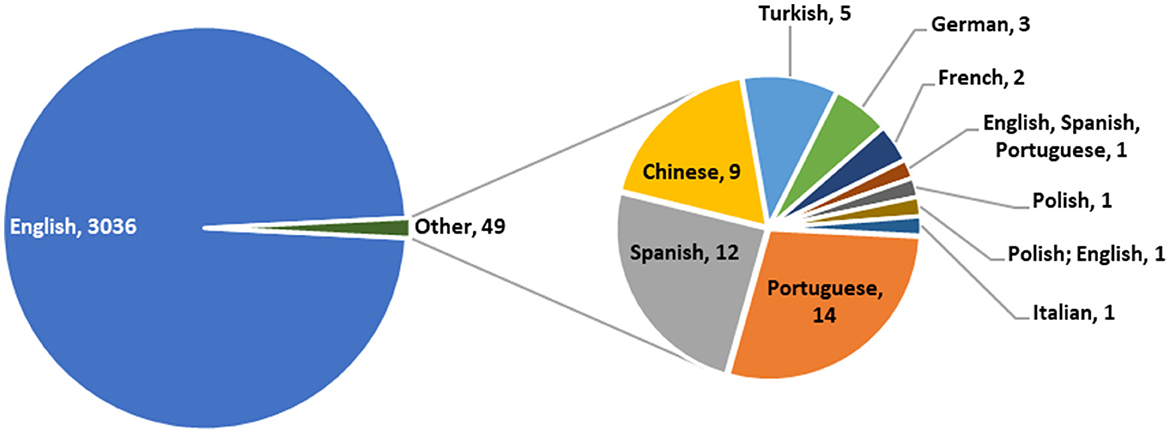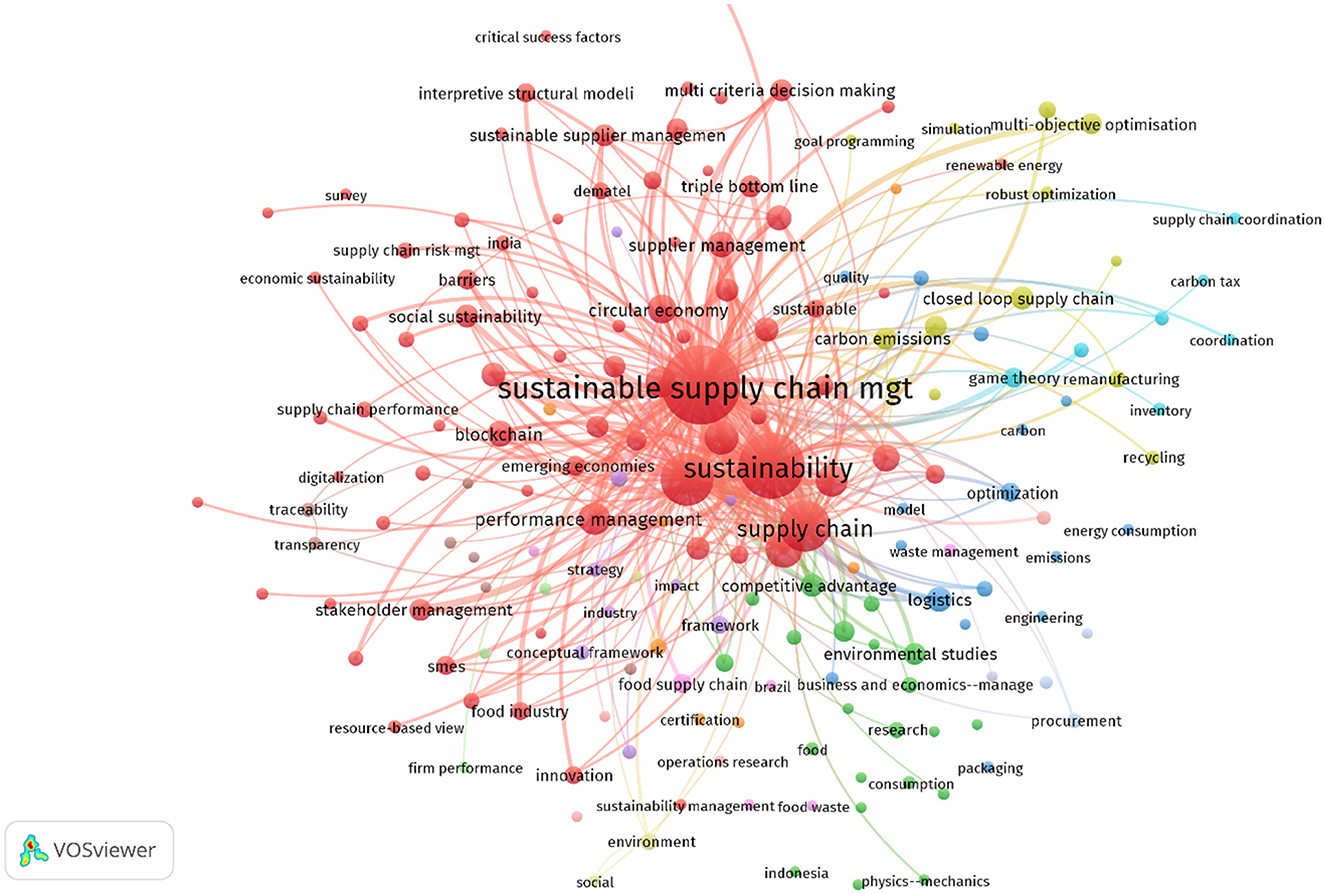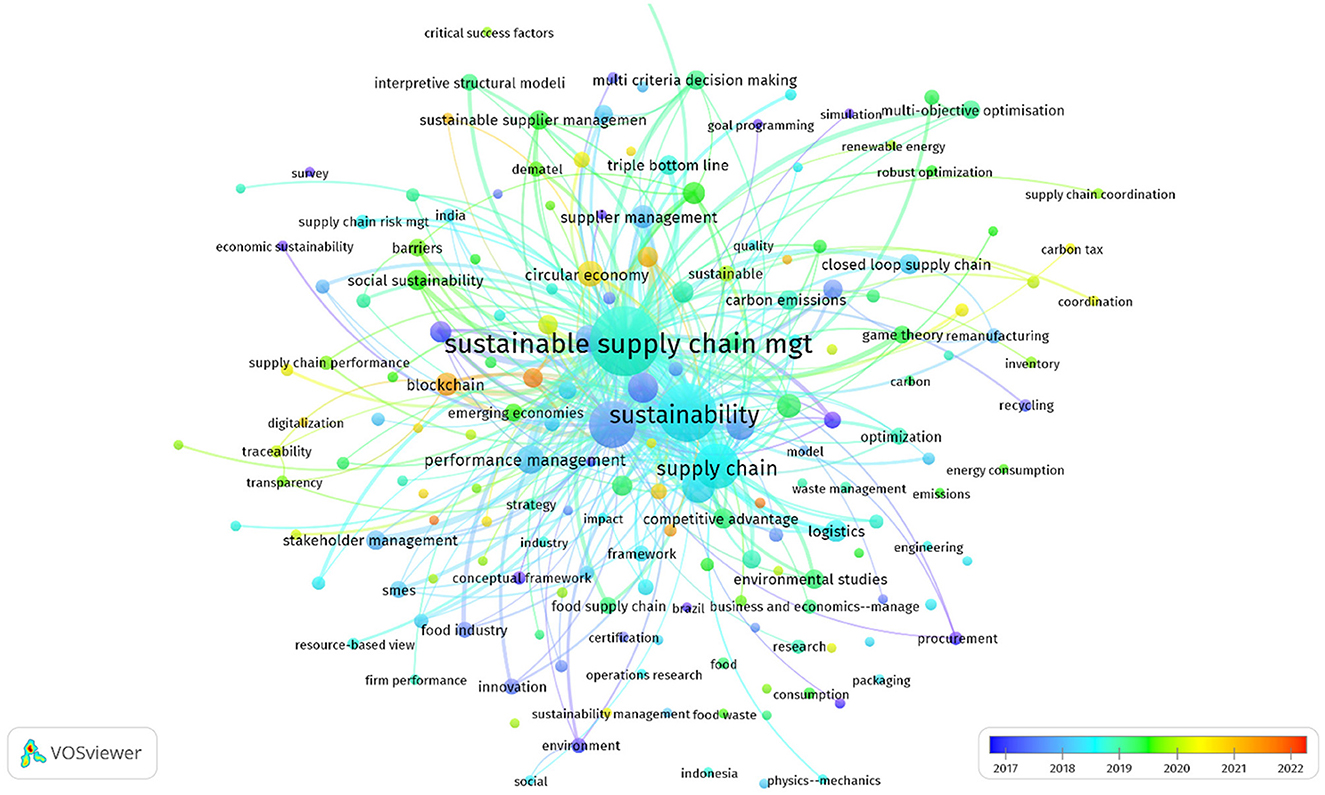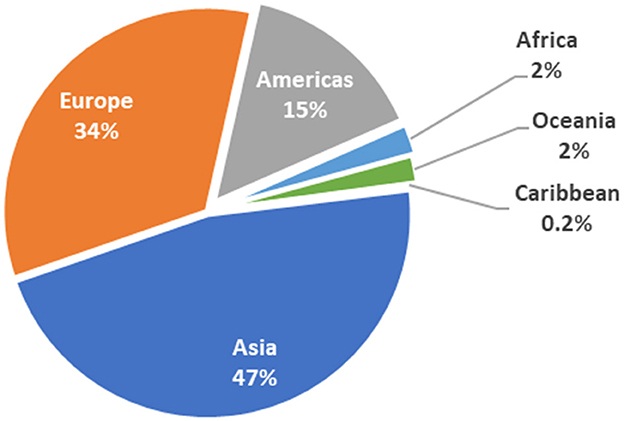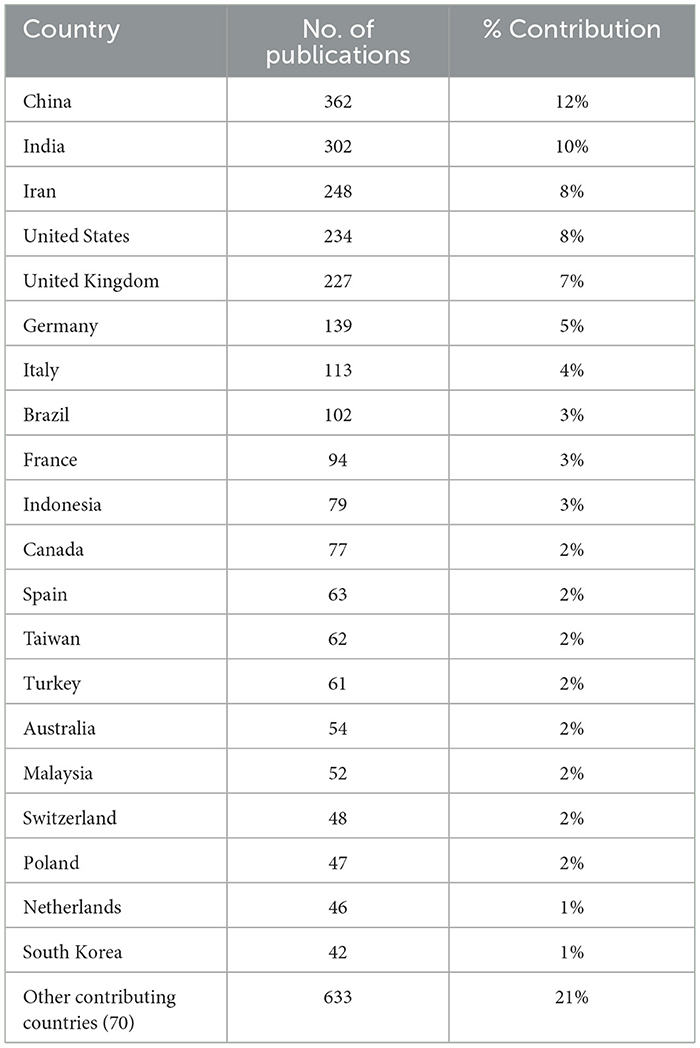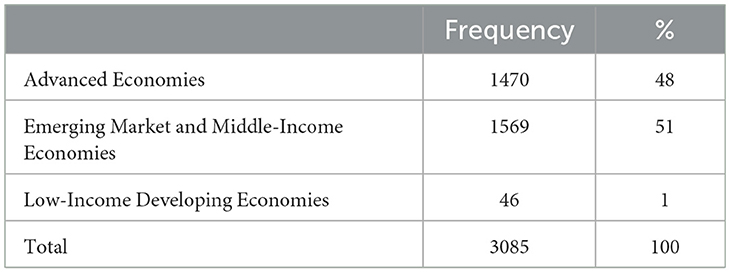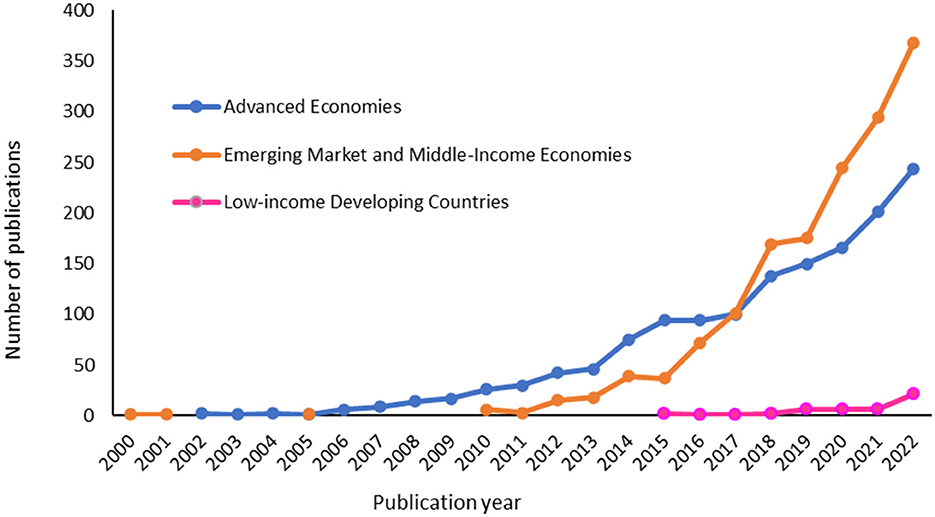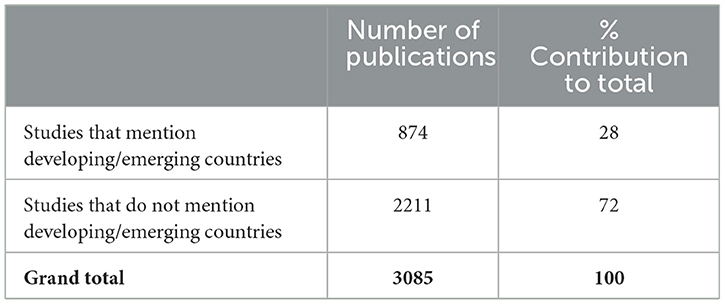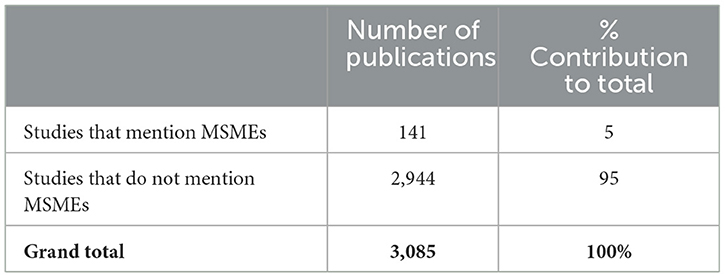Mapping the trends of sustainable supply chain management research: a bibliometric analysis of peer-reviewed articles
- 1Aberdeen Business School, Robert Gordon University, Aberdeen, United Kingdom
- 2Leeds Business School, Leeds Beckett University, Leeds, United Kingdom
This bibliometric analysis explores the scope and knowledge base of scholarly efforts on sustainable supply chain management (SSCM) and how it has evolved in different economies and businesses to advance circular economy (CE) discourses in theory and practice across economies and businesses. Using the Preferred Reporting Items for Systematic Reviews and Meta-analysis (PRISMA) guidelines and search syntax, a total of 2,574 peer-reviewed articles from journals indexed in Web of Science, Scopus, and ProQuest were analyzed. The results show an exponential growth in SSCM research since 2013 with 6,306 authors from 83 countries published in 675 journals; however, less attention is given to developing economies (DEs) and Micro, Small and Medium Enterprises (MSMEs). The findings provide a useful direction for future research and theory development in SSCM, allowing scholars and businesses to implement true CE by addressing practical sustainability issues relevant to their operations and supply chains. This bibliometric analysis is the first study providing a holistic overview of SSCM research trends in developed countries (DCs), DEs, and MSMEs, and arguing for inter-disciplinary CE discourses and inter-organizational collaboration in SC to update and implement CE. This study makes important contributions to SSCM research and practice by providing multiple snapshots of the increasing growth trajectory of the idea of sustainability in SC and how its different aspects have evolved over the period.
1. Introduction
Industrialization, increasing consumerism, technological advancements, and globalization have reshaped the economies of various countries (Hahn et al., 2015; Malik, 2018), leading to negative consequences of business activities on the environment, society, and global economy. In recent times, however, there has been increasing agitations from stakeholders, including policymakers, practitioners, scholars, and activists, for businesses to be sustainable in their operations (Seuring and Müller, 2008; Alshura and Awawdeh, 2016). Despite the increasing awareness of the consequences of business activities, leading to stakeholders' interest in sustainable supply chain (SSC) (Seuring and Müller, 2008; Carter and Easton, 2011), the approach in the literature is fragmented (Forslund et al., 2021), leading to misconceptions about SSC (Ahi and Searcy, 2013). Such approach undermines the contribution and role of supply chains (SCs) in implementing and achieving a true and impact-oriented circular economy (CE) throughout the organization system elements if scholars' (Seuring and Müller, 2008; Carter and Easton, 2011; such as Ahi and Searcy, 2013) perceptions of SSCM are valid. For instance, SSC and Green Supply Chain (GSC) are used interchangeably, and their constituents are vaguely defined in the literature, although it may be argued that the two approaches overlap. While SSC is broader, encompassing social, environmental, economic, ethical, and governance issues across a supply chain (SC), GSC is a sub-set of SSC, addressing only the environmental aspect of SCs. To highlight the confusion regarding sustainability in supply chain management (SCM), 22 definitions of green supply chain management (GSCM) and 12 definitions of sustainable supply chain management (SSCM) were reported in the literature (Ahi and Searcy, 2013). Although authors use SSCM and GSCM interchangeably leading to discursive confusion, this bibliometric analysis focuses on SSCM. The lack of clarity about SSC, coupled with the misalignment of SSC to SCM, suggests that the current knowledge is insufficient in designing effective and resilient SSC (Pagell and Shevchenko, 2014). Nonetheless, Pagell and Shevchenko (2014) argued that SSCM should be considered part of the mainstream SC rather than a separate individual stream for practitioners and researchers to design effective and impactful SSC. As a result, we define SSCM in this study as the coordination of the business system elements, including internal and external operations of businesses that are directly and indirectly involved in producing goods and delivering services, such that the business operations have little or no negative effects on stakeholders across the SC.
Consistent with our definition, businesses need to develop efficiencies within their operations and processes throughout their SCs to achieve effectiveness in their SC and improve sustainability performance (Amini and Bienstock, 2014). For businesses to incorporate sustainability into their operations, new operations processes and innovations are required, contingent on capabilities and SC collaborations. Businesses should align the internal and external aspects of their operations with the sustainability expectations of suppliers and customers to enhance sustainability across the entire SC (Seuring and Müller, 2008; Zhu et al., 2012). This alignment provides the basis for a true CE and could be enhanced when all players in the SC prioritize sustainability, eradicating the possibility of goal conflicts between SC players (Forslund et al., 2021). On the one hand, businesses should address sustainability issues associated with their operations and those of their partners across the entire SC, suggesting the need to identify sustainability as one of the key performance objectives of operations and suppliers' selection criteria (Alshura and Awawdeh, 2016; Mendoza-Fong et al., 2017). This reinvention of operations processes can enhance the ability of businesses to develop an impactful CE through their SC beyond the idea of waste management and recycling.
On the other hand, the corporate sustainability agenda should consider the complexity of business operations' political and governance, economic, social, and technological settings for businesses to deliver value to stakeholders across their SC. Businesses are impacted differently based on the industry type, location, size, and customers (Johnson et al., 2014), indicating that they should contextualize the SC sustainability and CE agenda to their business environment to address sustainability issues associated with their operations and SC. Businesses, depending on size and location, face different challenges and issues when integrating sustainability into their operations (Johnson et al., 2014; Hong et al., 2018; Wang et al., 2018) partly due to misconceptions about sustainability and its metrics.
In contrast to small businesses, large companies have the capabilities and resources to introduce innovations in their operations and across the entire SC, influencing their vendors and partners (Wang et al., 2018). Although small and medium-sized enterprises (SMEs) have financial and resource constraints, they have the advantage of faster decision-making due to a shorter organizational hierarchy (Hassini et al., 2012; Wang et al., 2018). Compared to large corporations, governance structure, shorter chain of command and faster decision-making can facilitate new thinking and innovations within small- and medium-sized businesses. While business size influences sustainability, location, with disparate contextual attributes, such as the legal framework, national and organizational culture, and people's sustainability orientation, affect how businesses adopt and implement sustainability. For example, businesses in developing economies (DEs) encounter more impediments than their counterparts in developed countries (DCs) when adopting sustainability practices in their operations and SC (Silvestre, 2015). These challenges are more pronounced for micro and small businesses in Africa and Asia, reducing their ability to uptake and implement CE. Contextual factors such as weak policies, turbulent political environments, institutional voids, and higher cultural tolerance of corruption erode confidence and trust among SC partners, preventing SCs in DEs from advancing toward CE. SSCM principles and models adopted by businesses in DCs may not be effective for businesses, especially SMEs, in DEs (Hong et al., 2018), undermining their transition from a linear model of production toward a closed-loop model.
Despite these considerations, research on sustainability focuses chiefly on large corporations, with only a handful of studies on Micro, Small, and Mid-sized Enterprises (MSMEs) (Cantele and Zardini, 2018; Kot, 2018). Extant research has not sufficiently addressed SSCM in DEs compared to their counterparts in DCs (Hong et al., 2018). For businesses in DEs to achieve circularity by reducing the tension between productivity and sustainability, there is a need for them to contextualize sustainability principles to their operations rather than applying the westernized epistemological and ontological perspectives of sustainability. This argument resonates with Hofstetter et al.'s (2022) observation that sustainability practices of suppliers in Africa have meager contributions to global value chains (GVC) that could be associated with the incongruence between the adopted SC (procurement) policies and the African context. This suggests a need for more research on the corporate implementation of SSCM in DEs, particularly those of MSMEs, due to their unique attributes and challenges compared to businesses in DCs when integrating sustainability into their SCs (Silvestre, 2015).
As a result, we sought to ascertain the scope and knowledge base of scholarly efforts on SSCM and how its many different aspects have evolved through research and practice to better understand the disparity in SSCM theory regarding differing economies and organizations. This understanding provides a basis to establish the scale and scope of research efforts on MSMEs in DEs and how they compare with DCs. The outcome will assist scholars and MSMEs in DEs address practical sustainability issues relevant to their business operations and SCs, bridging the gap between CE theory and practice and allowing organizations to implement and achieve a true CE. This bibliometric analysis of SSCM publications was designed to profile the genealogy of research on SSCM by analyzing parameters such as journals, year, countries, languages, authors, research methods, keywords, main research themes, and emerging topics. This review quantifies the SSCM research effort through bibliometric analysis of SSCM research, establishing dynamic changes over time. Its overarching purpose is to contribute to how sustainability in SCs is conceptualized and operationalized, providing a roadmap to further the advancement of SSCM as a unique discipline and practice within SCM, allowing organizations to develop and implement a true CE.
This bibliometric review addresses the following research questions to achieve the stated purpose:
1. What is the growth trajectory of SSCM publications in MSMEs?
2. What are the most influential journals and authors researching the field?
3. What are the main keywords and areas of research that have emerged in SSCM literature since its inception?
4. What is the geographical distribution, language and economic context of SSCM publications?
By answering these research questions, this review builds a conceptual bridge between the past, present, and future research agenda on SSCM and MSMEs, providing a roadmap for sustainability discourses to inform successful uptake of CE. We now outline our approach to the review and present our findings. We then discuss opportunities for sustainability and SC investigators to extend their research efforts and theorize SSCM within under-researched domains, such as MSMEs in DEs.
2. Materials and methods
For this bibliometric review, we followed the Preferred Reporting Items for Systematic Reviews and Meta-analysis (PRISMA) guidelines (Page et al., 2021) to analyze and synthesize the bibliographic information of published peer-reviewed studies on SSCM. The approach was preferred for this review due its transparency and the step-by-step procedure to identify, select, appraise, and synthesize relevant studies required to establish the state and direction of knowledge in SSCM. Consistent with Tranfield et al. (2003) guidelines, the review adopted a structured, transparent, reproducible approach to select and assess empirical evidence from relevant and reliable sources. This bibliometric review includes only scholarly peer-reviewed articles, excluding books, book chapters, conference proceedings, reviews and gray literature. The following section further explains the search criteria adopted in this study.
2.1. Search criteria and information sources
Search criteria were pre-determined and applied to ensure that relevant scholarly articles on SSCM were analyzed in this bibliometric analysis. These key inclusion and exclusion criteria were adopted:
1. Articles must be peer-reviewed before publication. Peer-reviewed articles were considered because such articles have been scrutinized and validated as original and significant by experts in the field (Kelly et al., 2014).
2. Systematic literature reviews, bibliometric literature reviews, and meta-analyses were excluded from this bibliometric literature review. These studies were excluded considering that the methods are generally applied to review relevant literature to address specific issues rather than empirically testing hypotheses or answering research questions.
3. The search was carried out without a specific timeframe. Due to the advances in technology innovation influencing how information is archived and retrieved over the years, we did not apply a specific timeframe. The timeframe was left open-ended to determine the growth trajectory from when the first publication appeared.
4. The search was carried out with no language limitations. Although most journals adopt English, the language was left open-ended in this bibliometric review to determine whether there are other languages that authors on SSCM have adopted.
We applied these pre-determined search criteria to three different repositories: Web of Science, Scopus, and ProQuest. The three repositories were preferred for this bibliometric review because they are considered multidisciplinary, providing a wider coverage for peer-reviewed articles and journals suitable for bibliometric and systematic literature review (Vatananan-Thesenvitz et al., 2019; Zhang et al., 2020). Using three databases instead of one allowed us to achieve a more comprehensive search capacity and identification of relevant sources (Zhang et al., 2020).
2.2. Search steps
The search was carried out using PRISMA's three-step process on 31 May 2022 and another search on the 25 January 2023 using the same process. The intention of the second search was to update the database and ensure that recent published articles were included in the analysis. The primary sets of keywords used for this review were “Sustainable Supply Chain”, “Sustainable Supply Chain Management”, “Sustainability in Supply Chain”, and “Supply Chain Sustainability”. The operator ‘OR' was used in all the databases to ensure that at least one search syntax was returned when all the phrases were searched (Clarivate Analytics, 2020; Cubias, 2021; Elsevier, 2021). To include all articles covering SSCM, we applied PRISMA's three-step (Figure 1) document search framework (Page et al., 2021).

Figure 1. PRISMA flow diagram for bibliometric literature review process (Adapted from Page et al., 2021).
In step 1, we searched the same sets of keywords in the three repositories without refinement or limitations. The keywords were searched in the available publications' Title, Abstract, and Author Keywords. For SCOPUS, we performed the search using the “TITLE-ABS-KEY” search field. For ProQuest, “Anywhere except full text (NOFT)” was selected, and for Web of Science, the “Topic” option was used. We then applied the inclusion and exclusion criteria to retrieve only peer-reviewed articles from across the three databases. The articles from this phase excluded non-peer-reviewed articles such as features, reports, commentary?, editorial?, general information?, conference proceedings?, and correction/retraction.
In step 2, we searched the keywords as exact phrases rather than unrelated words in the retrieved peer-reviewed journal articles from Step 1. The approach allowed us to refine the search string by applying a Boolean operator and quotation marks (“ “).
In step 3, we combined the three databases to identify and remove duplicates. Due to the three databases employed in this study to retrieve peer-reviewed articles, we uploaded the articles that met the inclusion criteria into Mendeley, a reference management software by Elsevier (Mendeley, 2022). By uploading peer-reviewed articles from the three databases into Mendeley Library, we were able to search duplicates and organize articles based on their relevance. We applied its duplicate management function to identify and remove duplicates from the combined database. After removing the duplicates, we searched and removed literature reviews, including bibliometric review, systematic literature review, and meta-analysis. We then manually checked for any ineligible papers and remaining duplicates not identifiable due to minor discrepancies during indexing.
The initial search (step 1) yielded a total of 90,270 studies (Figure 1) from the three databases: Scopus, ProQuest, and Web of Science. After applying the inclusion and exclusion criteria, 36,775 peer-reviewed articles were potentially eligible for review. The step 2 resulted in a total of 5,597 after applying the Boolean operator and quotation marks, representing only 6% of the 90,270 articles that were initially obtained from step 1. The duplicate search in step 3 resulted in 3,166 peer-reviewed articles after removing 2,431 duplicates from the combined record. Further screening revealed that 81 articles were not eligible for this current bibliometric literature review. After removing the duplicates and ineligible reviews from the combined record, a total of 3,085 peer-reviewed articles were finally considered eligible for this bibliometric analysis.
The final eligible articles for this review were then downloaded as an RIS file for use in VOSviewer, and as an XML file into MS Excel for further analysis. VOSviewer is a free software program used to generate and visualize bibliometric networks (Van Eck and Waltman, 2010; VOSviewer, 2023). VOSviewer is one of the most used bibliometric software in Scientometrics and other disciplines including management, environmental science, and medicine (Orduña-Malea and Costas, 2021). VOSviewer was selected as a bibliometric tool due to its ease of use and simplicity for constructing network maps of co-occurring keywords and co-authorship from titles, keywords, and abstracts (VOSviewer, 2023).
For analyzing the interrelations between keywords of this dataset, we performed a co-occurrence of keywords using the VoSViewer tool. Similarly, we applied VOSviewer to analyze the co-authorship network. VOSviewer settings were calibrated using “author” as the unit of analysis, with the counting method set for fractional counting and the minimum number of documents per author set at one for each publication to have the same overall weight and to reveal as much interconnectedness as possible. We later applied VoSViewer text mining capabilities in this bibliometric analysis to generate network visualization of co-authorship and keywords, allowing for a detailed exploration of the generated maps. We performed additional analysis to quantify the research effort in DCs and DEs or ECs by using the International Monetary Fund (IMF, 2021) system to categorize countries contributing to SSCM research.
We used MS Excel to enter, store, organize data, and observe patterns from the screened data obtained from the search using its Sort and Filter functions. The software allowed us to gather insights from the data by performing calculations and analysis through its Find, Autosums, V-Lookups and Pivot tables. We utilized the Pivot Table function in MS Excel to identify contributing author countries as well as to subtotal number of publications per country. For ease of reporting and visualization, MS Excel's reporting and visualization functions enabled us to present the results in tables and charts.
3. Results and discussion
The results presented here are sub-classified into different thematic areas relevant to the goals of this bibliometric analysis.
3.1. Growth trajectory of SSCM publications
The growth trajectory (Figure 2) of the published articles on SSCM shows that research on SSCM has been ongoing for the past 23 years. However, the research effort was considerably slower in the first decade (between 2000 and 2010), with about 3% of all research output available in the specified period. As shown in Figure 2, SSCM literature emerged in 2000, after which publications increased by an average of 30% per year. The publication trends provide an understanding of the importance of sustainability, especially in SCM, within the research community.
Our results further show that the word “sustainability” appeared alongside SC for the first time in 1989 from diverse sources such as features, reports, commentary?, editorial?, general information?, and conference proceedings. Despite being engrained in many cultures and its contributions to CE, sustainability and SC started appearing together by 1991 in peer-reviewed journals.
It was not until 2000 that the phrase “sustainable supply chain” first appeared in a peer-reviewed journal. From the year 2000 to date (27/01/2023), the analysis shows that a total of 3,058 peer-reviewed journal articles were published with exact phrases like “sustainable supply chain”, “sustainable supply chain management”, “sustainability in supply chain”, and “supply chain sustainability”. Although the field started gaining prominence in 2008, there has been an exponential increase in published peer-reviewed articles since 2014 (Figure 2).
In contrast to the first decade (i.e., 2000 – 2010), there was an explosion of research efforts in the second decade (2011 to 27 January 2023), representing over 97% of all research outputs in the latter period. This result shows that the published studies on SSCM have increased from an average of eight articles a year in the first decade to an average of 247 articles a year in the second decade, representing over 3000% growth. Further analysis shows that SSCM literature has gained the highest prominence within the last 9 years, possibly due to stakeholders' increasing awareness of the negative effects of human and business activities. In support of this view, 37 articles have already been published in the first month of 2023, representing about half of the total number of articles published in the first decade. With the current growth trajectory, our projection (see the exponential trend line in Figure 2) suggests that more than 800 peer-reviewed articles will be published in 2023. The projection is partially due to the renewed interest in sustainability and the concerted efforts to achieve a CE and reduce greenhouse gas emissions across SCs (i.e., scope 3 emissions). With the increasing interest in sustainability and CE, there is a need for scholars and practitioners to further explore how SC could drive CE by embedding sustainability into an organization's internal and external networks.
To make sense of these observations, we put the growth trajectory of SSCM literature in the perspective of key milestones within the history of sustainability (Figure 3). It is observed that while many significant United Nations-led and non-United Nations-led sustainability events occurred before the year 2000, this did not translate into any literature in SSCM in that period.
However, the year 2000 provided a solid foundation for sustainability research and practice with the creation of the UN Global Compact and the UN Millennium Summit that resulted in the Millennium Development Goals (MDGs). It is worth noting that the first Global Reporting Initiative (GRI) guideline for sustainability reporting by businesses was also launched in 2000. Despite the launch of these very business-specific sustainability initiatives, only one article on SSCM was published in 2000, the pattern that continued similarly until about 2005. The situation could be attributed to misconceptions about sustainability, its conceptualization and how it should be operationalized in research and practice (Simpson and Radford, 2012). Although the analysis reveals a low research output in the first decade, an average of two papers a year in the first six years, the number of publications increased to six papers in 2006. This sudden jump in the number of publications in 2006 may have been influenced by the Kyoto Protocol becoming legally binding in 2005. It may have also been influenced to a lesser extent by publication lag due to journals' peer-review process. A similar trend is observed between 2007 and 2008, where publications nearly doubled after the UN Global Compact Leaders' Summit and the European Commission's Beyond GDP Conference in 2007.
Situating this pattern against the sustainability timeline in Figure 3, we argue that the explosion of literature in the second decade is influenced by events that relate to corporate involvement in achieving sustainability and CE. These include the creation of the Sustainability Accounting Standards Board in 2011, the release of the International Integrated Reporting in 2013, and the adoption of the 2030 Agenda for Sustainable Development [along with 17 Sustainable Development Goals (SDGs)] in 2015. Another important event was the signing of the Paris Agreement by 196 countries in 2015 to reduce global carbon emissions to net-zero by 2050. More recent events, COP25 in 2019 and COP26 in 2021, have contributed to the increasing growth trajectory of peer-reviewed articles on SSCM, supporting our projections for 2023. This observation indicates a potential correlation between scholars' interests in SSCM and increasing awareness on sustainability issues through legally binding agreements and high-profile international events. It could also mean that businesses are propagating disinformation about the real impacts of their activities and SCs to attract customers due to the increasing agitation from stakeholders whenever there is an important sustainability-related event that spurs research efforts and related publications on sustainability. While there is increasing awareness of sustainability (Forslund et al., 2021), there is a need to understand how stakeholders including customers perceive sustainability for businesses to address real issues, that are important to customers, in their operations and across the SC.
3.2. Journal analysis
The analysis shows that 776 journals published 3,085 SSCM articles over the 23 years. The breakdown (Table 1) shows that 481 journals (62%) published only one article each, 286 journals (37%) published between two and 50 articles, while only nine journals (1%) published more than 50 articles over the 23 years.
Although 776 journals have published at least one article, further analysis (Table 2) shows that SSCM literature is dominated primarily by two main journals, the Journal of Cleaner Production (JCP) and Sustainability (Switzerland). These two journals account for more than 20% of the published SSCM peer-reviewed articles, suggesting the need for journals across different disciplines to show more research interest in SSCM and be receptive to SSCM articles. The receptiveness could foster inter-disciplinary research on how businesses could uptake and implement sustainability in their operations and across the supply chain.
Despite the dominance of the two journals, we observed that SSCM attracts increasing interest from diverse academic disciplines. Table 2 shows that these disciplines include Business, Management and Accounting; Computer Science; Decision Sciences; Economics, Econometrics and Finance; Environmental Science; Energy, Engineering (including Manufacturing); Mathematics; and Social Sciences. The disparate disciplines contribute to the fragmentation of sustainability and SSCM, introducing a variety of perspectives and paradigms on how SC is designed and managed for sustainability. Those views show the relevance and importance of SC to all businesses irrespective of their operations, size, and location; however, the challenges facing businesses are different, suggesting that a one-size-fits-all approach to SSC is problematic and may not present desirable outcomes in all cases. They further indicate the need for a multifaceted, interdisciplinary policy and practice underpinned by multidisciplinary research, addressing the gap between theory and practice, particularly to reduce tensions between economic productivity and sustainability.
3.3. Authorship and co-authorship
Additional analysis was performed on authorship and co-authorship, using VOSviewer 1.6.19 (VOSviewer, 2023) to identify and understand the contributions of authors to the field in terms of the number of publications and collaboration. The analysis resulted in three outcomes and allowed us to map authors (Figure 4), with the most contribution, to SSCM research and link strength to other authors. The first outcome was an author count where the total number of authors contributing to all the identified SSCM papers. The second outcome was author ranking where VOSviewer ranked the authors based on the number of documents per author, and the co-authorship link strength to other authors. The third outcome was a co-authorship network visualization map, showing the relationships among the top authors of SSCM literature based on document weights, scored at average publications per year.
This bibliometric analysis shows that the identified 3,085 articles were published by 7,454 authors, making important contributions to the field. We further generated a co-authorship network map (Figure 4) by retaining the previous settings in VOSviewer (i.e., author as the unit of analysis) and maintaining the minimum number of documents per author to 1. Using this approach, we identified 549 leading and emerging authors in the field of SSCM with the highest level of connectedness.
The co-authorship visualization (Figure 4) illustrates the relationships among the top authors of SSCM literature based on document weights scored at average publications per year. Results showed that Joseph Sarkis, Stefan Seuring, Kannan Govindan, Angappa Gunasekaran, Reza Farzipoor Saen, Ming-Lang Tseng, and Angappa Gunasekaran are the most prominent authors based on the number of articles published. These six authors also represent authors with the most co-authorship and demonstrate strong connections with other authors.
Many early scholars, such as Mark Pagell, Zhaohui Wu, Robert Klassen, Peter Byrne and Vaidyanatha Jayaraman, laid a strong foundation for developing the field. However, scholars such as Stefan Seuring, Stefan Gold, Joseph Sarkis, Angappa Gunasekaran, Kannan Govindan, and Dubey Rameshwar became prominent between 2014 and 2018. From 2019 to date, the field of SSCM has experienced the contribution of emerging scholars, such as Biswajit Sarkar, Ming Lim, Simonov Kusi-Sarpong, Rakesh Raut and Minelle Silva. Our findings suggest that the volume of publications and the number of researchers working in this field are growing, especially in recent years (i.e., 2019–2022), consistent with the increasing interests in corporate sustainability. With the increasing interests in sustainability and the disparity in the way sustainability is conceptualized (Simpson and Radford, 2012; Forslund et al., 2021), collaborative research efforts between scholars across different countries and socio-economic jurisdictions may stimulate the emergence of more cohesive discourses of sustainability to render the concept more accessible to practitioners.
3.4. Language analysis
Over the years, systematic literature review, bibliometric literature review, and meta-analysis approaches and studies have been strongly biased toward the English Language, with authors searching and synthesizing studies published only in English. With studies in other languages often neglected, possibly due to language barrier, we performed language analysis to recognize the various languages that authors on SSCM have adopted. According to our findings (Figure 5), articles on SSCM have been published in eight different languages, although English remains the dominant language, accounting for about 98% of all the identified papers.
Other languages, such as Chinese, German, French, Polish, Portuguese, Spanish, and Turkish, represent only about 2% of the published articles. This overrepresentation of English in SSCM research might be due to the adoption of the English language by the high-profile journals involved in SSCM publications. With authors from non-English speaking countries forcing themselves to publish their studies in English, their efficiency might be reduced, undermining the quality of their studies, including the findings' reliability and validity. To establish mechanisms for countries to create enabling environments that support corporate sustainability (Hofstetter et al., 2022), authors should have the opportunity to publish articles in the native language, allowing them to address fundamental sustainability issues affecting their jurisdiction. The other languages provide some indication of the geographical spread of the field and suggest the need to address potential Anglo-American bias that may not align with social, economic and environmental differences, particularly in DEs. However, it is a limitation of our bibliometric analysis that we did not search to confirm whether there are articles published in more than one language. The search could establish whether authors publish in English and their native language together in a single paper (or on a title).
3.5. Keyword analysis
Considering the interdisciplinary nature of research on SSCM, we further analyzed keywords to identify commonly used words in the field and their association. The objective was to identify the most prolific emerging keywords when searching and retrieving relevant articles. To achieve this purpose, we uploaded the same RIS file used in the authorship analysis into VOSviewer and performed keywords occurrence analysis in VOSviewer (2023). Using this program, “keywords” was set as the unit of analysis and the minimum number of occurrences of a keyword related to SSCM to 10. The minimum number of 10 was adopted based on many journals' requirements to include keywords in published articles. This action produced two outcomes. The first keyword analysis outcome was a total keyword count of the total number of keywords found in all the identified papers. The second outcome was a network visualization map, indicating the relationships among the most frequently used SSCM keywords based on document weights and an overlay map with its color coding illustrates how various keywords have been introduced into SSCM research over time.
In total, 7,265 different keywords were found from the 3,085 articles; however, 178 keywords were highlighted as having been mentioned at least 10 times and having some connections with other keywords (Figure 6).
From the network visualization of the top keywords and their interconnection with other keywords (Figure 6), the top keywords with more than 200 occurrences are sustainable supply chain management, sustainability, supply chain management, supply chain, and sustainable development. These five keywords, which appeared nearly 40% more than all the others combined, are the foundation and fundamental keywords in SSCM literature, providing a conceptual understanding of key terms in SSCM. Authors frequently use other keywords, including circular economy, corporate social responsibility, decision making, performance management, green supply chain management, and environmental management, accounting for between 90 and 200 occurrences.
To appreciate the contributions of SSCM, particularly with the progression in the use of keywords since 2011, when the field started gaining traction, the yearly overlay visualization of the keywords (Figure 7) shows exponential growth in the number of different keywords. It is worth noting that certain keywords, such as Circular Economy, Social Sustainability, Sustainable Supplier Selection, Industry 4.0, Supply Chain Performance, Blockchain, Digital Transformation, Internet of Things, Artificial Intelligence, Big Data, and Robust Optimization are more prevalent between 2018 and 2022, reflecting the state and the direction of research on SSCM. As expected, Covid-19 emerged as a new keyword, appearing 59 times, and linked to other keywords such as Resilience, Logistics, Decision Making, Circular Economy, Supply Chain Resilience, and Performance Management. This observation suggests that future research efforts may benefit from focusing on how businesses could build a resilient and efficient SC through SSCM.
We further analyzed keywords based on MSMEs/SMEs and DEs or emerging economies (ECs) to understand the state and direction of research efforts on Micro, Small, and Medium-sized Enterprises (MSMEs/SMEs) and the disparity between DCs and DEs. This analysis is extremely important as it provides scholars an understanding of how research interests on sustainability in SC across nations could shape CE discourses and whether a universal approach on how to implement CE could be proposed considering that CE is now a prominent emerging word in SSCM research. The results show that China (25 times), India (24 times), and Indonesia (11 times) appeared as keywords within the 3,085 papers. ECs (47 times) and DEs (28 times) appeared as separate keywords among the top 178. Although SMEs (38 times) emerged strongly in 2018, the occurrence and link strength are weak compared to the five keywords that we considered the foundation and fundamental keywords in SSCM.
3.6. Geographical analysis
We utilized MS Excel functionalities, such as Pivot Table, to perform a geographical analysis based on author locations and the total number of publications per country. Using fractional counting, only the first author's location was used as a unit of analysis to ensure consistency across all the identified records. We observed from the analysis that the geographical coverage of research on SSCM is unbalanced and the authors' location does not necessarily translate to the research context. For instance, we observed that some authors are based in North America or Europe, but their research focused on SSCM in Asian countries. This practice could bias research findings and influence how sustainability, especially for CE, is conceived and designed, which could be difficult for businesses to implement due to the lack of consideration for local culture and other contextual attributes when proposing CE. However, we used the location of the main author as the unit of analysis where more than one author exists for a publication. The results (Figure 8) show that 90 countries have contributed to research on SSCM. The breakdown reveals that 32 countries from Asia contributed 47% of all SSCM research, 33 European countries contributed 34%, nine American countries accounted for 14%, two Oceanian countries contributed 2%, and 10 African countries accounted for 2% of the entire research outputs, and two Caribbean countries contributed <1%.
Our analysis shows that countries in America, Asia, and Europe dominated the publications on SSCM, with very little contribution from Oceania, the Caribbean, and Africa. The lack of research on SSCM from Africa echoes Yenkey and Hill (2022) observation that sustainable development in African countries lag other countries. Although 90 countries have contributed to the literature on SSCM, our analysis shows that 50% of all the publications were from only six countries, namely China, India, the United States, Iran, the United Kingdom, and Germany (Table 3). Interestingly, only 20 countries contributed 80% of all SSCM publications, with 70 countries accounting for the remaining 20%.
The dearth of publications from Africa and Oceania highlights the effects of institutional challenges and suggests the need for scholars in African and Oceanian countries to be proactive in addressing micro-level sustainability issues. Without engaging scholars and practitioners from African countries in sustainability and CE discourses, the whole idea of CE could be meaningless and unsuccessful due to the complexity and interconnectedness of global SC. Considering the contribution of DEs, especially African countries, to the global trade and economy, more research on SSCM in Africa is required especially in Management literature, allowing local firms to engage with their suppliers in addressing sustainability issues in their SC, beyond the idea of corporate social responsibility (CSR) and waste recycling. While the expansion of global trade could facilitate pollution offshoring and depletion of natural resources (Yenkey and Hill, 2022), more research on SC allows firms to understand how mechanisms, such as SC visibility and traceability, could be achieved to identify sustainability issues and unethical practices within their SC for true CE.
Further analysis revealed that while 32 different countries from Asia contributed to SSCM publications, 63% of publications from this region came from only three countries, namely China (362 publications), India (302 publications), and Iran (248 publications). Similarly for Europe, 33 countries are involved in SSCM research, and mostly driven by the United Kingdom (227 publications), Germany (139 publications), Italy (113 publications), and France (94 publications), and Spain (63 publications) with a combined contribution of about 60% of the region's performance. In North America, contribution to SSCM research is driven by the United States (234 publications) and Canada (77 publications). While 10 African countries have published SSCM research, South Africa (24 publications), Egypt (15 publications), and Morocco (15 publications) are the most contributors in the region. Brazil and Colombia are the key contributors to SSCM research from South America, with a joint contribution of about 90% for the region. Finally, all the contributions from the fourteen countries of the Oceania region are from Australia (54 publications) and New Zealand (11 publications).
3.7. Economic context
To quantify the amount of research effort in DCs and DEs or ECs, we employed the International Monetary Fund (IMF, 2021) system to categorize the 83 countries contributing to SSCM research. These categories are advanced economies, emerging market and middle-income economies, and low-income developing economies. These classifications are informed by factors such as per capita income level, export diversification, and degree of integration into the global financial system (IMF, 2021). According to the results (Table 4), advanced economies, and emerging market and middle-income economies contributed 99% of all publications. In contrast, countries from low-income developing economies contributed only 1% of the publications; there is a need for scholars in these economies to enhance their research efforts and contribute to the ongoing global discussion on sustainability and CE.
Further analysis was performed to understand the yearly contribution of each classification of countries to the field. According to the results (Figure 9), there was little research output from the low-income developing countries and the emerging market and middle economies in the first decade, contrary to the consistent effort from authors in advanced economies.
We found no publication on SSCM from authors in low-income developing economies before 2015. Our analysis (Figure 9) shows that their contribution to the field since 2015 has been comparatively minimal (1% of the total publication output) consistent with section 3.6. However, authors in the emerging markets and middle-income economies have been increasingly showing interest in the last 5 years. While the advanced economies have always had higher research outputs than the emerging markets and middle-income economies, this trend has changed significantly since 2017. From the analysis, we observed that authors from emerging markets and middle-income economies published an average of 30% more papers than authors in advanced economies since 2017. The change of pattern in the research outputs from emerging markets and middle-income countries was driven largely by authors from Brazil, China, India, and Iran.
3.8. Research focus
We performed additional analysis to identify and quantify studies that included DEs, ECs and/or MSMEs as part (or focus) of their investigation. This analysis is necessary considering the lack of clarity about articles that address SSC issues in DEs despite the SSCM research attracting interest from different authors across many disciplines in developed and emerging economies. We applied the “search and find” function in MS Excel to scan titles and abstracts of all the articles under review to identify articles focused on DEs. The following predefined syntax was applied: developingcountr*, developingeconom*, emergingcountr*, and emergingEconom*. Further analysis was conducted using country names not classified as Advanced or Developed Economies based on the IMF classification to ensure that all the relevant articles were identified. Articles were coded ‘Yes' if they focused on developing/emerging economies and ‘No' if they were outside developing/emerging economies or not specified. According to the findings (Table 5), 875 studies (28%) from the 3,085 eligible articles mentioned DEs or ECs in their title and/or abstract.
Furthermore, we scanned through each article's title and abstract using Micro Small and Medium Enterprises, Small Business, Small Scale Micro Business, Medium Business, SMEs, and MSMEs to identify articles that addressed MSMEs. Articles were coded ‘Yes' if MSMEs were specified and ‘No' if they were outside MSMEs or not specified. The results (Table 6) show that only 5% of the reviewed studies mentioned MSMEs, and 95% did not.
A cross-tabulation analysis was conducted to identify the relationship between the studies' focus, MSMEs and developing/emerging economies. The intention was to understand whether studies that investigated MSMEs also considered developing/emerging economies in their investigation. According to the results (Table 7), 66 papers mentioned MSMEs but not DEs or ECs, whereas 800 papers mentioned DEs or ECs but not MSMEs. The results further show that 2,144 papers, representing 70% of the reviewed articles, neither mentioned MSMEs nor developing/emerging countries. However, only 74 papers, representing about 2.4% of all the reviewed articles, mentioned both developing/emerging countries and MSMEs in the same article.
While only 74 published articles mentioned both MSMEs and DEs or ECs in the same article, further analysis (Figure 10) showed that the first articles in this category were published 10 years after SSCM publications emerged. Despite the 87 published articles on SSCM between 2000 and 2010, none mentioned DEs or ECs and MSMEs in the same article. Furthermore, findings highlighted that publications mentioning MSMEs and DEs or ECs in the same article are about an average of seven papers a year after the first publication in 2011. We observed that no article mentioning MSMEs and DEs was published in 2012 and 2013. While there was an exponential increase in published SSCM articles in 2017, only one article mentioning both MSMEs and DEs or ECs was published in that year. This lack of publication could be due to the peer-review process rather than the lack of research efforts. It highlights the disparity of reported research between DCs and DEs, suggesting that SSCM is a concept far more prevalent in DCs than DEs. This bias in research activity should be factored into theories of SSCM and related corporate practices including policy development, particularly international policies. This understanding is important for SSCM research and practice in DEs, assisting scholars and practitioners to focus their attention on critical sustainability issues affecting MSMEs in DEs.
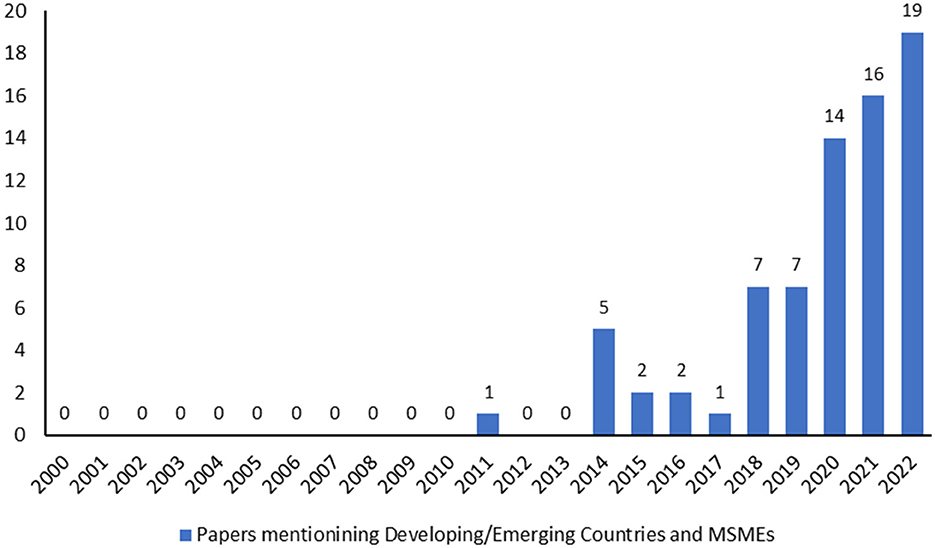
Figure 10. Annual Growth Trajectory of Literature on SSCM, mentioning both MSMEs and developing countries in the same article.
4. Discussion and conclusion
This study ascertains the scope and pattern of research efforts on SSCM and how its many different aspects have evolved. Our aim was to quantify the SSCM research by conducting a bibliometric analysis of peer-reviewed empirical articles within academic journals to map the emergence of this field of research. To achieve this aim, we explored three different databases that are mostly used for bibliometric and systematic literature reviews (Vatananan-Thesenvitz et al., 2019; Zhang et al., 2020), for completeness and applied bibliometric analysis methods to establish patterns of SSCM research and evolution of themes to highlight the direction of future research on SSCM and on MSMEs. The goal was to understand how scholars and practitioners across different businesses and economies could contribute to discourses on sustainability in SC that could provide pathways for businesses to develop a true and impactful CE.
5. Key findings
The results indicate the increasing number of published SSCM studies by an average of 30% per year since it first emerged in 2000. While 776 journals are associated with SSCM research, the Journal of Cleaner Production and Sustainability (Switzerland) are the most influential and consistent journals, producing nearly 20% of all SSCM publications to date. The dominance of these journals suggests the need for management journals to support scholars, especially in DEs, in addressing practical sustainability and unethical issues of business operations in their jurisdiction to encourage a true CE beyond waste management and recycling. This support could be in terms of special issue (SI) focusing on DEs and funding for research works, allowing them to contextualize CE design and implementation, through SSCM, to their jurisdictions.
Our results show that 7,454 scholars have published peer-reviewed articles on SSCM; however, only a handful of authors are prominent in the field. With the exponential growth in publications and increasing interest in sustainability, the SSCM field is now attracting many new authors. This observation is a good development in theorizing SSCM for its practical applications in addressing the consequences of business operations across their entire value chains for businesses and nations to address real sustainability issues and achieve CE through SSCM.
While there are re-occurring keywords, such as Sustainability, Sustainable Supply Chain, Sustainable Supply Chain Management (SSCM), Supply Chain Management (SCM), Supply Chain(s), and Sustainable Development, we observed that certain keywords are more prevalent since 2018. These keywords include circular economy, social sustainability, sustainable supplier selection, industry 4.0, supply chain performance, blockchain, and robust optimization. Accurate use of these keywords for article indexing will assist scholars when searching for relevant studies on SSCM or tagging their studies with the trend/pattern of sustainability research in SCM. It allows the use of common terminologies for research and practice, making it easier for businesses, especially in DEs to translate research findings in addressing sustainability issues facing their operations.
Our results show that the field is not attracting the same attention in DEs/ECs as in DCs despite the volume research on SSCM, which is consistent with Hofstetter et al. (2022) observation. The analysis further shows that authors are mostly interested in large organizations compared to MSMEs, demonstrating a lack of research on MSMEs in DEs/ECs which could affect how businesses could perceive their transition from a linear model of production toward a circular model. The dearth of research on SSCM in MSMEs, particularly in DEs might be responsible for a lack of capability for MSMEs in DEs to design/apply a formal SCM strategy and the mindset that CE is only relevant to large corporations. The practical implication is that the westernized conceptualizations of sustainability in SC is transported to DEs/ECs which might not align with the contextual situations of those countries, undermining their efforts in implementing CE. We advocate for more research on SSCM in MSMEs, particularly in DEs, for MSMEs to develop appropriate capabilities in designing/applying a formal SCM strategy that could allow them to embed sustainability into their SCs. Such capabilities could result in concerted efforts between businesses or government bodies around the world to improve sustainability (Hofstetter et al., 2022).
This bibliometric review demonstrates an explosion in the number of published peer-reviewed papers on SSCM with the increasing numbers of journals, authors, keywords and contributing countries. This study indicates the relevance and contribution of SSCM to current contemporary debates about the consequences of business activities, providing more insights into addressing issues facing the operations and SCs of businesses.
6. Limitations and future work
For this bibliometric analysis, we searched Scopus, ProQuest, and Web of Science databases and identified 3,085 eligible articles based on the pre-determined search criteria. While these databases are recommended for bibliometric and systematic literature reviews by scholars (Vatananan-Thesenvitz et al., 2019; Zhang et al., 2020), we considered their adoption in this bibliometric analysis as a limitation of our study due to our observation of a long lag time between when articles are published and when they are indexed in these databases. Future analysis may consider additional databases including those that index business/technical reports and search organizational repositories for gray articles.
Despite stakeholders' heightened interest, including scholars, this has not resulted in equal attention given to SSCM efforts in and research on MSMEs, particularly in developing/emerging countries. For the SCM field to contribute significantly to the ongoing sustainability and CE discourses, we argue that scholars and practitioners, especially in developing/emerging economies, should focus on practical issues facing businesses in their jurisdictions. Focusing on practical businesses sustainability issues could facilitate inter-disciplinary and multinational collaborations, allowing for comparator studies within and between DEs and DCs to understand whether SSCM principles and models adopted by businesses in DCs are equally effective for businesses in DEs. Without this understanding and collaboration, it will be difficult to effectively mitigate climate change and sustainability issues at global level, undermining the efforts of stakeholders, especially the United Nations, in achieving the global emission reduction targets.
Author contributions
BA, AO, and ZM contributed to conception and design of the study. BA organized the database and conducted the statistical analysis. AO assessed the appropriateness of the analysis. BA and AO re-assessed the database and conducted further analysis. BA wrote the first draft of the manuscript. AO and ZM reviewed and developed the final manuscript. All authors contributed to manuscript revision, read, and approved the submitted version.
Conflict of interest
The authors declare that the research was conducted in the absence of any commercial or financial relationships that could be construed as a potential conflict of interest.
Publisher's note
All claims expressed in this article are solely those of the authors and do not necessarily represent those of their affiliated organizations, or those of the publisher, the editors and the reviewers. Any product that may be evaluated in this article, or claim that may be made by its manufacturer, is not guaranteed or endorsed by the publisher.
References
Ahi, P., and Searcy, C. (2013). A comparative literature analysis of definitions for green and sustainable supply chain management. J. Cleaner Prod. 52, 329–341. doi: 10.1016/j.jclepro.2013.02.018
Alshura, M. S., and Awawdeh, H. Z. Y. (2016). Green supply chain practices as determinants of achieving green performance of extractive industries in Jordan. Int. J. Bus. Soc. Sci. 7, 166–177.
Amini, M., and Bienstock, C. C. (2014). Corporate sustainability: an integrative definition and framework to evaluate corporate practice and guide academic research. J. Cleaner Prod. 76, 12–19. doi: 10.1016/j.jclepro.2014.02.016
Cantele, S., and Zardini, A. (2018). Is sustainability a competitive advantage for small businesses? An empirical analysis of possible mediators in the sustainability–financial performance relationship. J. Cleaner Prod. 182, 166–176. doi: 10.1016/j.jclepro.2018.02.016
Carter, C. R., and Easton, P. L. (2011). Sustainable supply chain management: evolution and future directions. Int. J. Phys. Distrib. 41, 4–62. doi: 10.1108/09600031111101420
Clarivate Analytics (2020). Web of Science Core Collection Help. Available online at: https://images.webofknowledge.com/images/help/WOS/hs_search_operators.html (accessed April 27, 2021).
Cubias, L. (2021). LibGuides: ProQuest Platform: ProQuest Platform Search Tips. Available online at: https://proquest.libguides.com/proquestplatform/tips (accessed April 27, 2021).
Elsevier (2021). Scopus Search Guide. Available online at: http://schema.elsevier.com/dtds/document/bkapi/search/SCOPUSSearchTips.htm (accessed April 27, 2021).
Forslund, H., Björklund, M., and Ülgen, V. S. (2021). Challenges in extending sustainability across a transport supply chain. Supply Chain Manage. Int. J. 27, 1–16. doi: 10.1108/SCM-06-2020-0285
Hahn, T., Pinkse, J., Preuss, L., and Figge, F. (2015). Tensions in corporate sustainability: towards an integrative framework. J. Bus. Ethics 127, 297–316. doi: 10.1007/s10551-014-2047-5
Hassini, E., Surti, C., and Searcy, C. (2012). A literature review and a case study of sustainable supply chains with a focus on metrics. Int. J. Prod. Econ. 140, 69–82. doi: 10.1016/j.ijpe.2012.01.042
Hofstetter, J. S., McGahan, A. M., Silverman, B. S., and Zoogah, B. D. (2022). Sustainability and global value chains in Africa: Introduction to the Special Issue. Africa J. Manage. 8, 1–14. doi: 10.1080/23322373.2021.2018220
Hong, J., Zhang, Y., and Ding, M. (2018). Sustainable supply chain management practices, supply chain dynamic capabilities, and enterprise performance. J. Cleaner Prod. 172, 3508–3519. doi: 10.1016/j.jclepro.2017.06.093
IMF (2021). April 2020 WEO Database-Country Data Documentation IMF Code ISO Code Country Currency Historical Data Source 1 Latest Actual Annual Data Base Year 2 System of National Accounts Use of Chain-Weighted Methodology 3 Historical Data Source. Available online at: https://www.imf.org/external/pubs/ft/weo/2020/01/weodata/co.pdf (accessed November 26, 2021).
Johnson, G., Whittington, R., Angwin, D., Regnèr, P., and Scholes, K. (2014). Exploring Strategy. 10th Edn. Pearson: London.
Kelly, J., Sadeghieh, T., and Adeli, K. (2014). Peer review in scientific publications: benefits, critiques, and a survival guide. Int. Fed. Clin. Chemi. Lab. Med. 25, 227–243.
Kot, S. (2018). Sustainable supply chain management in small and medium enterprises. Sustainability 10, 1143. doi: 10.3390/su10041143
Malik, A. (2018). The main driver of social unsustainability and its remedy. Int. J. Soc. Econ. 45, 973–988. doi: 10.1108/IJSE-01-2017-0005
Mendeley (2022). Mendeley Reference Manager. Available online at: https://www.mendeley.com/reference-management/reference-manager (accessed May 27, 2021).
Mendoza-Fong, J. R., García-Alcaraz, J. L., Díaz-Reza, J. R., Diez Muro, J. C. S., and Fernández, J. B. (2017). The role of green and traditional supplier attributes on business performance. Sustainability 9, 1520. doi: 10.3390/su9091520
Orduña-Malea, E., and Costas, R. (2021). Link-based approach to study scientific software usage: the case of VOSviewer. Scientometrics 126, 8153–8186. doi: 10.1007/s11192-021-04082-y
Page, M. J., McKenzie, J. E., Bossuyt, P. M., Boutron, I., Hoffmann, T. C., Mulrow, C. D., et al. (2021). The PRISMA 2020 statement: An updated guideline for reporting systematic reviews. Syst. Rev. 10, 1–11. doi: 10.1186/s13643-021-01626-4
Pagell, M., and Shevchenko, A. (2014). Why research in sustainable supply chain management should have no future. J. Supply Chain Manage. 50, 44–55. doi: 10.1111/jscm.12037
Seuring, S., and Müller, M. (2008). From a literature review to a conceptual framework for sustainable supply chain management. J. Cleaner Prod. 16, 1699–1710. doi: 10.1016/j.jclepro.2008.04.020
Silvestre, B. S. (2015). Sustainable supply chain management in emerging economies: environmental turbulence, institutional voids and sustainability trajectories. Int. J. Prod. Econ. 167, 156–169. doi: 10.1016/j.ijpe.2015.05.025
Simpson, B. J., and Radford, S. K. (2012). Consumer perceptions of sustainability: a free elicitation study. J. Nonprofit Pub. Sector Marketing 24, 272–291. doi: 10.1080/10495142.2012.733654
Tranfield, D., Denyer, D., and Smart, P. (2003). Towards a methodology for developing evidence-informed management knowledge by means of systematic review. Br. J. Manage. 14, 207–222. doi: 10.1111/1467-8551.00375
Van Eck, N., and Waltman, L. (2010). Software survey: VOSviewer, a computer program for bibliometric mapping. Scientometrics 84, 523–538. doi: 10.1007/s11192-009-0146-3
Vatananan-Thesenvitz, R., Schaller, A. A., and Shannon, R. (2019). A bibliometric review of the knowledge base for innovation in sustainable development. Sustainability 11, 5783. doi: 10.3390/su11205783
VOSviewer (2023). Manual for VOSviewer Version 1.6.19. Available online at: https://www.vosviewer.com/documentation/Manual_VOSviewer_1.6.19.pdf (accessed January 24, 2023).
Wang, J., Zhang, Y., and Goh, M. (2018). Moderating the role of firm size in sustainable performance improvement through sustainable supply chain management. Sustainability 10, 1654. doi: 10.3390/su10051654
Yenkey, C. B., and Hill, N. R. (2022). Trade and sustainability: three decades of change across Africa. Afr. J. Manage. 8, 109–142. doi: 10.1080/23322373.2021.2001290
Zhang, X., Yu, Y., and Zhang, N. (2020). Sustainable supply chain management under big data: a bibliometric analysis. J. Enterprise Inf. Manage. 34, 427–445. doi: 10.1108/JEIM-12-2019-0381
Keywords: bibliometric analysis, circular economy, micro, small and medium-sized enterprises, sustainable supply chain management, supply chain management, sustainability
Citation: Amofa B, Oke A and Morrison Z (2023) Mapping the trends of sustainable supply chain management research: a bibliometric analysis of peer-reviewed articles. Front. Sustain. 4:1129046. doi: 10.3389/frsus.2023.1129046
Received: 21 December 2022; Accepted: 06 April 2023;
Published: 21 April 2023.
Edited by:
Núria Bautista-Puig, University of Gävle, SwedenReviewed by:
Miriam Borchardt, University of the Rio dos Sinos Valley, BrazilElpidio Nara, Pontifical Catholic University of Parana, Brazil
Andres Pandiella-Dominique, Universidad Carlos III de Madrid, Spain
Copyright © 2023 Amofa, Oke and Morrison. This is an open-access article distributed under the terms of the Creative Commons Attribution License (CC BY). The use, distribution or reproduction in other forums is permitted, provided the original author(s) and the copyright owner(s) are credited and that the original publication in this journal is cited, in accordance with accepted academic practice. No use, distribution or reproduction is permitted which does not comply with these terms.
*Correspondence: Adekunle Oke, a.oke@leedsbeckett.ac.uk
 Birago Amofa
Birago Amofa Adekunle Oke
Adekunle Oke Zoe Morrison
Zoe Morrison